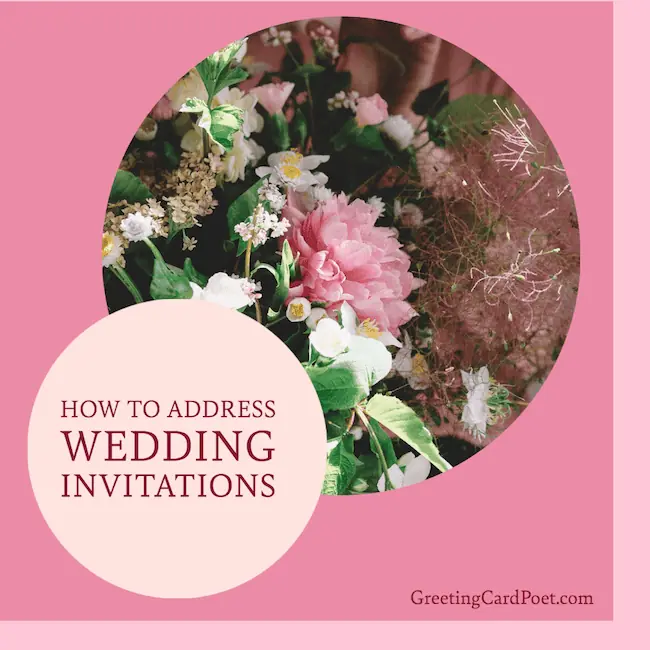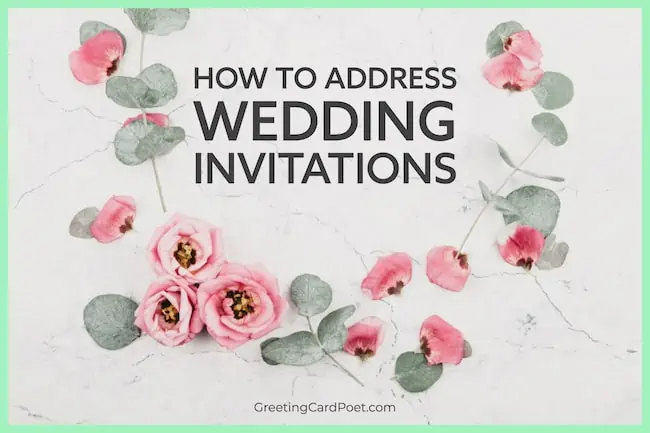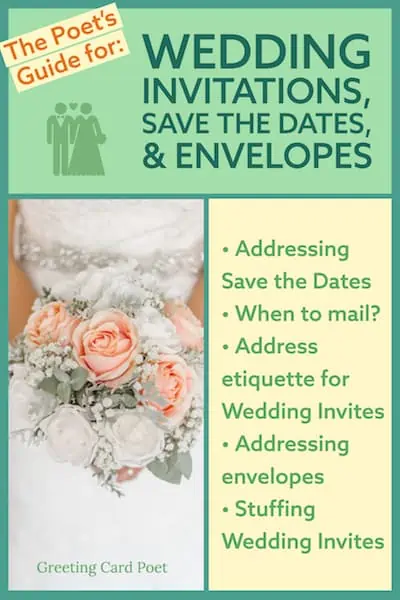How to Address Wedding Invitations Guide
Our How to Address Wedding Invitations Guide addresses not only wedding invites but also save the dates notes.
So, you’ve picked a date, and the big day is on the calendar, but now what? Where do you begin? Do you create a list of things to do? Should you create a guest list first? Which family members will you invite?
What is the budget? Where will the wedding ceremony take place? Will it be a local wedding or a destination wedding? So many questions and so little time.
We’re here to help you with one critical component of your wedding: the wedding invitations. The best place to start is to create a comprehensive guest list in alphabetical order.

Order Your List
The reason to put the list in alphabetical order is it will be easier to track when you have completed specific tasks for each guest. Also, it gives you a reference guide for the seating chart (but that comes a lot later).
You may want to begin by determining how many people you will invite; you’ll want to factor in your budget. List the person you are planning to invite and make sure if it is a couple, list both of their names together.
If you believe that the person you are inviting will bring a date, but you’re not sure who, make a note of plus one. This will give you an evolving headcount so you know when you’ve reached your limit of guests.
Wedding Invitations Address Etiquette Guide
The etiquette for addressing wedding envelopes is much the same as the Save the Date cards. The outer envelope should be addressed more formally with Mr. and Mrs. and full names and titles when appropriate.
At the same time, the outer envelope might have Mr. John and Mrs. Sally Simpson. The inner envelope could be Mr. and Mrs. Simpson or just John and Sally.
If your guests are a married couple with different last names, use Mr. and Mrs. For example, Mr. Jim Nelson and Mrs. Nancy White. A divorced female should be addressed as Ms., as can a widowed, married woman. However, it is appropriate to use Mrs. for a widow.
An unmarried couple living together should be Mr. and Ms. A same-sex couple should be Ms. and Ms. or Mr. and Mr.
You might like our Maid of Honor Speech Tips and Examples.

Addressing Guests with Specific Titles
Married doctors can be addressed to Doctors Allan and Jane Alden on the outer envelope and The Doctors Alden on the inner envelope.
If a married woman is a doctor and her husband is not, the woman’s name should come first on the outer envelope—for example, Dr. Susan Parker and Mr. Michael Parker or Dr. Susan and Michael Parker.
If the professional titles of a married couple won’t fit on a single line, use a separate line on the front of the envelope.
When addressing wedding invitations to military personnel, they should be addressed by ranks, such as Captain James Billings and Mrs. Sally Billings. Judges should be addressed as “The Honorable,” like the Honorable Elizabeth Hudson and Mr. George Hudson.
The same holds when you address wedding invitations to Reverends. The Reverend Nancy Peterson and Mr. Todd Paterson, or if both parties are reverends, The Reverends Todd and Nancy Peterson. A priest should be addressed as “Father.” These distinguished titles should receive the respect they deserve on the outer envelope of the wedding invitation.
How to Address Wedding Invitations to a Family
When addressing the wedding invitations of family members, there are some easy ways to handle this. If an invitation is going to an entire family, it can be addressed to the parents on the outer envelope, Mr. Timothy and Mrs. Barbara Gordon.
Then, on the inner envelope, Timothy, Barbara, Miss Colleen, and Graham. Female children under 18 are addressed as Miss, and male children do not receive a Mr. until they reach 18.
If adult children (18 and older) of wedding guests are invited, they should receive their own separate invitations—for example, Ms. Colleen Gordon and Mr. Graham Gordon. If you do not want to invite children to your wedding, that should be printed clearly on the invitations.
Invitations to Grandparents, Aunts, Uncles, and Cousins should be addressed formally on the outer envelope. On the inner envelope, it is perfectly acceptable to address Grandpa Joe and Grandma Bette, Uncle Bob, Aunt Karen, or Cousin Jesse.
You might like our Maid of Honor Speech Tips and Examples.
When to Send Out Wedding Invitations
Wedding invitations should be sent two to three months before the wedding date. This gives guests plenty of time to plan travel arrangements, book accommodations, and schedule time off from work.
If the wedding is a destination wedding, the invitations should be sent out three months before the event. And, if it is a local wedding, it should be two months.
If you are using a calligrapher, you should plan on touching base with them a month before you plan on sending your invitations. Many printers will print your return address, and guest addresses directly on the envelopes. Again, give the printer enough time to get the printing done before sending them.
Before sending the wedding invitations, you need to decide what the RSVP date should be. Ideally, this would be about three weeks before the wedding. You should check with your caterer and venue to make sure that works for them. This provides time to create seating arrangements, designate arrangements, make placement cards, and design signage.
If you haven’t heard from specific guests and the wedding date is looming closely (two weeks before). It is appropriate to contact them by phone or email to get a response.
How to Properly Address an Envelope
If you are addressing the invitations yourself, make sure you allow enough time to complete this task. Check the date you want to send the invitations out and work back from there. Once you know how long it takes to address the outer and inner envelopes (and stuff them), you can determine how long the process will take.
It is a good idea to number the alphabetical guest list you created in the beginning. Then, discreetly write that number on the back of the RSVP card. This allows you to track who has responded, even if they forgot to write their names.
Again, using the list, double-check name spelling and addresses before writing on the outer envelope. The inner envelope performs the essential function of listing exactly who is invited and who isn’t. As listed earlier, younger children’s names that are invited are written on the inner envelope.
Return Address on Wedding Invitations
For the return address on the outer envelope, the bride’s address, the bride’s parents’ address, or whoever is hosting the wedding’s address can be used. Usually, this address is printed on the back flap of the envelope. The same address is printed on the front of the RSVP envelope. The inner envelope does not have an address printed on it.
Including the return address on the outer envelope and RSVP envelope is a key part of the process. If guests are unable to come, this address serves as the place to send wedding gifts.
The addresses may not be pre-printed on the envelopes, or you may not be using a calligrapher. In that case, make certain you use the same color pen when writing all addresses. Black is the most common ink color.

How to Stuff Wedding Invitations
Before stuffing the wedding invitations, assemble all of the components that will be going into the outer envelope. These may include, but not be limited to, an RSVP card and postage-paid return envelope, printed directions or map, and information on additional events.
After the names have been written on the inner envelope, the invitation is placed in the inner envelope. For a folded invitation, it is placed in the inner envelope folded edge down front-facing.
If it is a single card, it should be placed left edge down and also front-facing. This means guests will see the printed invitation once they have opened the inner envelope.
The assembled components listed above should be stacked from smallest to largest and placed inside the folded invitation or in front of the single card. The inner envelope is placed unsealed in the already addressed outer envelope. Names and addresses should be double or triple-checked before mailing.
Once you have fully assembled the invitation, you should bring it to the post office to determine how much postage will be needed. The addition of multiple items may make the postage more than a standard letter.
A few websites even offer personalized stamps that will have a picture of the bride and groom and the correct postage. You can also ask the post office to hand stamp the envelopes, which many feel is more attractive than the machine stamp.
Some Other Handy Information
The information and printed pieces you provide to your wedding guests are valuable tools to help your guests enjoy your wedding. A map or directions is a handy take-along piece to find the wedding and reception venues.
Many couples opt for a day after the wedding brunch, and information concerning that event or others is in the invitation. For destination weddings, there may be a separate card that contains information on arranged transportation. Information on preferred-rate hotels near the venue may also be included.
In addition, there is a growing trend of couples creating websites specifically for their wedding. This custom URL can be used to reinforce the information that is already in the printed invitation. It gives guests a handy reference point to check on wedding details, especially if they’ve lost or forgotten their invitation.
The URL can double as a gift registry. It has a handy, comprehensive list of all of the wedding gifts the bride and groom are looking for and where to buy them. There is usually a list of shops, restaurants, and bars in the immediate area. It may contain entertainment ideas, things to see, places to go, and key attractions found near the wedding site.
Another growing trend is gift bags. These bags or boxes are assembled and left at the hotel(s) of the guests. They can contain a map of the surrounding area, one or two bottled waters, or an apple and/or orange.
A couple of pieces of candy, a salty snack, a hand-written note of thanks, or an adult beverage are nice touches. Anything that strikes your fancy and will be enjoyed by your guests.
How to Address Save the Dates
Before you make out the wedding invitations, it’s a good idea to send out a “Save the Date” notice. Since you have established when the wedding will be, you want all of your guests to save the date on their calendars.
This is especially important if it is a destination wedding and guests need to schedule vacation time. Here is a brief breakdown of the different kinds of Save the Available Date notices.
Many couples decide to send out a save-the-date postcard that is standard postcard size. The problem with this is that sometimes a standard postcard can get lost in the shuffle. Because of this, many couples choose a card and envelope design. But if it is a perfectly square card, there will be an additional postage charge.
If you get really creative, you can print and send Save the Date magnets that guests can keep on their refrigerators. An alternative to this is stickers that can be placed in a guest’s calendar. Many couples are deciding to go paperless and send out an email save-the-date. This also gives guests the option to respond to the date.
There are two styles to choose from when addressing Save the Date cards formal and informal. This is determined by how well you know the guest. You could choose Mr. and Mrs. Robinson (for a married couple), or Bill and Shelly Robinson if they are close friends.
This is the same for titles too. You can use Dr. and Mrs. Smith if they are acquaintances or if they are friends, Sam and Donna Smith. Also, if you are allowing plus-ones, the address should include “and guest.”
When to Mail Save the Dates
Save the Date notices should be sent six to ten months before the wedding date if it is a “local” wedding. For destination weddings, Save the Date cards can be sent up to a year in advance. This gives guests plenty of time to plan for the event. You for time off or put some savings together.
What you don’t want to do is send Save the Date cards out too close to the wedding (for example, less than three months) because this could cause more scheduling conflicts.
Congratulations on your upcoming wedding, and enjoy the whole event and process!
By Tim Moodie
Tim Moodie is a Freelance Writer and Product Developer. He spent many years writing greeting cards of all kinds, including Engagement Cards and Wedding Cards for Recycled Paper Products. In addition, his daughter Colleen just got married in February.
Extra Extra
You’re on the How to Address Wedding Invitations Guide page.
You might like:
